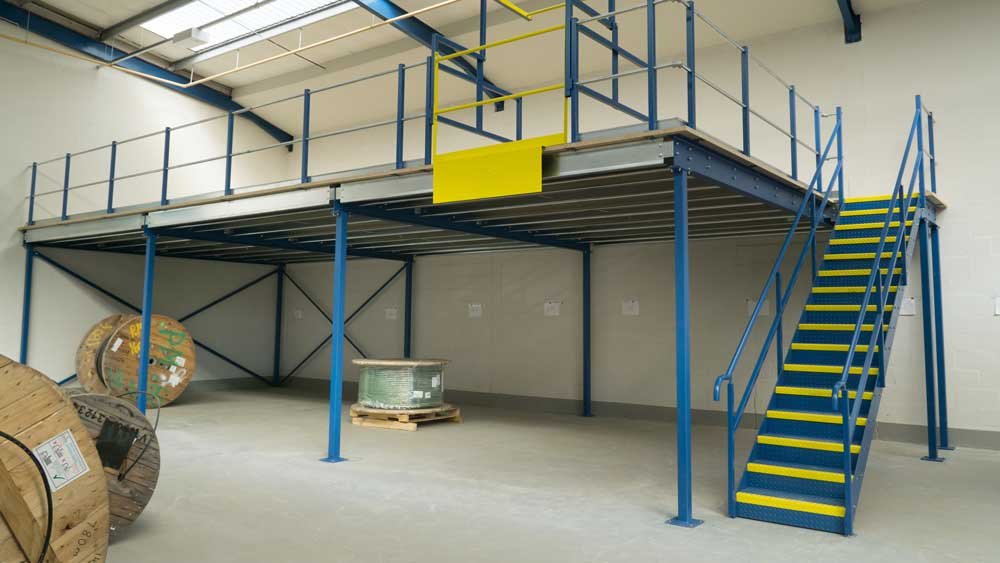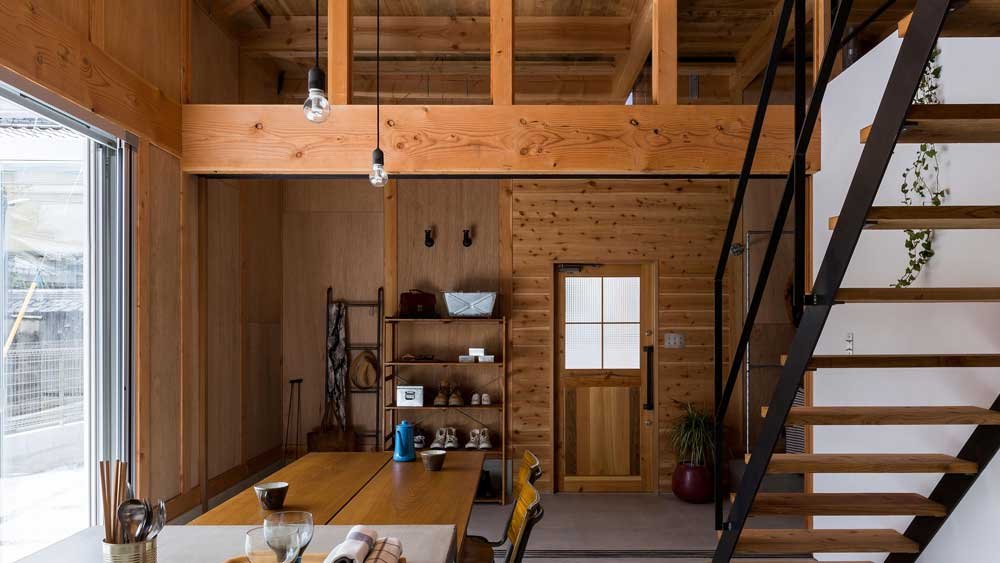In the shelving system, the mezzanine that we commonly see is usually modular in design and supported by a steel frame structure, so its main material is also steel-based. But have you ever heard of the wooden mezzanine?
In some specific usage scenarios, in pursuit of a more natural and warm environment, wooden mezzanine is obviously a good choice. Although wooden mezzanine is usually seldom found in professional storage environments, if you are interested in it, you may also want to listen to see what we, as a professional storage rack manufacturer, have to say about it!

What is wood mezzanine?
Wood mezzanine typically uses high-strength lumber (such as plywood, hardwood, or engineered wood) as the primary structural material. However, although wood is not as strong as steel, wood mezzanines are usually lighter and are suitable for scenarios where less load-bearing is required. In particular, the natural grain and color of wood make it suitable for use in retail stores, cafes, exhibition halls, and other locations where aesthetics are required.
Wood mezzanine has the advantages of lower cost, easier processing and better thermal and acoustic insulation. But it also has some disadvantages that cannot be ignored, such as limited load-bearing capacity, low durability, poor fire resistance and restricted spanning capacity.
So while wood mezzanine is inferior to steel mezzanine in terms of load bearing and durability, it has unique advantages in terms of aesthetics, cost and environmental friendliness. It is particularly suitable for light storage, retail, catering and exhibition scenarios. If you need a natural, warm and affordable space solution, wood mezzanine is an option worth considering!

How to calculate wood mezzanine loads?
Calculating the load-bearing capacity of wood mezzanine involves mainly the basic principles of structural engineering, including load calculation, material strength analysis and structural design. Below are the calculation steps that we feel are feasible:
Understanding Load Types
Before calculating the load, it is essential to identify the two primary types of loads:
Dead Load: The weight of the mezzanine structure itself, including the weight of fixed components such as wood, flooring, and guardrails.
Live Load: The variable weight of people, equipment, goods, etc., moving on the mezzanine.
Calculating Dead Load
The dead load is the weight of the mezzanine structure itself, typically calculated in pounds per square foot (psf) or kilograms per square meter (kg/m²).
Steps:
Determine Material Weight:
Wood Weight: Based on the type and dimensions of the wood, find its unit weight.
For example:
A 2×10-inch laminated veneer lumber (LVL) beam weighs approximately 2.5 pounds per linear foot.
3/4-inch thick plywood weighs approximately 2.2 pounds per square foot.
Floor Weight:
Calculate based on the material and thickness of the flooring.
Weight of guardrails and other fixed fixtures.
Calculate Total Area:
Total area of the mezzanine = length × width.
Calculate Total Dead Load:
Total dead load = (wood weight + floor weight + weight of other fixtures) × total area.
Calculating Live Load
The live load is the weight of people, equipment, or goods moving on the mezzanine, typically determined by the usage scenario.
Common Live Load Standards:
Residential or office areas: 40-50 psf (approximately 1.9-2.4 kN/m²).
Retail or commercial areas: 60-100 psf (approximately 2.9-4.8 kN/m²).
Storage areas: Determined by the weight of stored items, typically 125-250 psf (approximately 6-12 kN/m²).
Steps:
Determine Usage Scenario: Select the appropriate live load standard based on the intended use of the mezzanine.
Calculate Total Live Load:
Total live load = live load standard × total area.
Calculating Total Load
The total load is the sum of the dead load and live load, used to assess the load-bearing capacity of the mezzanine.
Formula:
Total load = Dead load + Live load.
Checking Wood Load-Bearing Capacity
Based on the total load, check whether the selected wood’s load-bearing capacity meets the requirements.
Steps:
Find the Allowable Load of the Wood:
Use span tables or engineering manuals to find the maximum allowable load for the selected wood.
For example, a 2×10-inch LVL beam with a span of 4 meters has an allowable load of 300 psf.
Compare Total Load with Allowable Load:
If total load ≤ allowable load, the design is safe.
If total load > allowable load, additional support or higher-strength wood is needed.
Considering Safety Factor
In practical design, a safety factor (typically 1.5-2.0) is usually added to ensure the mezzanine remains safe under extreme conditions.
Formula:
Design load = Total load × Safety factor.
Example Calculation
Assume you are designing a wooden mezzanine with dimensions of 5 meters × 4 meters, using 2×10-inch LVL beams and 3/4-inch thick plywood flooring.
Calculate Dead Load:
Wood Weight: 2.5 pounds per linear foot × 5 meters × 3.28 feet/meter = 41 pounds.
Floor Weight: 2.2 pounds per square foot × (5 meters × 4 meters × 10.764 square feet/square meter) = 473 pounds.
Total dead load = 41 + 473 = 514 pounds.
Calculate Live Load:
Assuming the mezzanine is for office use, the live load standard is 50 psf.
Total live load = 50 psf × (5 meters × 4 meters × 10.764 square feet/square meter) = 10,764 pounds.
Calculate Total Load:
Total load = 514 + 10,764 = 11,278 pounds.
Check Wood Load-Bearing Capacity:
A 2×10-inch LVL beam with a span of 4 meters has an allowable load of 300 psf.
Total load = 11,278 pounds / (5 meters × 4 meters × 10.764 square feet/square meter) = 52 psf.
52 psf < 300 psf, the design is safe.
Factors to Consider When Designing a Wood Mezzanine
Dead Load
Dead load refers to the weight of the mezzanine structure itself, including all fixed components. Key considerations include:
- Wood Weight: The weight of beams, columns, flooring, and other wooden elements.
- Flooring Materials: The weight of plywood, solid wood planks, or other flooring materials.
- Railings and Stairs: The weight of railings, stairs, and their connectors.
- Other Fixed Fixtures: Items such as lighting, piping, and electrical cables.
Live Load
Live load refers to the weight of people, equipment, or goods on the mezzanine. Key considerations include:
- Usage Scenario: Different applications have varying live load standards (e.g., residential, office, retail, warehouse).
- Occupancy Density: The number of people expected to be on the mezzanine simultaneously.
- Equipment Weight: Machines, shelving, office equipment, etc.
- Goods Weight: If used for storage, the weight and distribution of stored items must be considered.
Mechanical Properties of Wood
The mechanical properties of wood are fundamental to load calculations. Key considerations include:
- Wood Type: Different wood species have varying strengths (e.g., pine, oak, plywood, LVL).
- Wood Dimensions: The cross-sectional size of beams and columns directly affects load-bearing capacity.
- Wood Grade: The grading of wood (e.g., Grade 1, Grade 2) determines its allowable stress limits.
Span and Support
The design of spans and support systems significantly impacts load capacity. Key considerations include:
- Beam Span: Longer spans reduce the load-bearing capacity of beams.
- Support Spacing: The spacing of support columns or walls affects load distribution.
- Support Type: The load-bearing capacity of wooden columns, steel columns, or walls differs.
Connection Methods
The method of connecting structural components directly affects the overall stability of the mezzanine. Key considerations include:
- Connector Type: Such as bolts, angle brackets, screws, etc.
- Connection Strength: The strength and quantity of connectors must meet load requirements.
- Connection Design: Ensuring that connection points effectively transfer loads.
Safety Factor
To account for unforeseen loads or material defects, a safety factor is typically applied. Key considerations include:
- Design Standards: Safety factors are determined based on local building codes (typically 1.5–2.0).
- Extreme Conditions: Additional safety margins for conditions such as earthquakes or wind loads.
Environmental Factors
Environmental conditions may affect wood performance and the mezzanine’s load capacity. Key considerations include:
- Humidity: High humidity can cause wood to swell or decay.
- Temperature: Temperature fluctuations can lead to wood shrinkage or cracking.
- Fire Resistance: Additional fireproofing measures may be required due to the flammability of wood.
Building Codes
Wood mezzanines must comply with local building regulations and safety standards. Key considerations include:
- Load Requirements: Minimum dead load and live load requirements specified in regulations.
- Railing Height: Typically required to be at least 1 meter.
- Staircase Design: Stair slope, width, and step height must meet code requirements.
Maintenance and Aging
The long-term load capacity of a mezzanine is influenced by wood aging and maintenance. Key considerations include:
- Anti-Corrosion Treatment: Preventing wood decay or insect infestation.
- Regular Inspections: Checking for cracks, deformations, or loose connectors.
- Repairs and Replacements: Timely repair or replacement of aging wood and connectors.
Conclusion
That’s all we have to say about wood mezzanine, we hope our content can help you! If you have more questions or needs about mezzanine, you are more than welcome to contact us!

